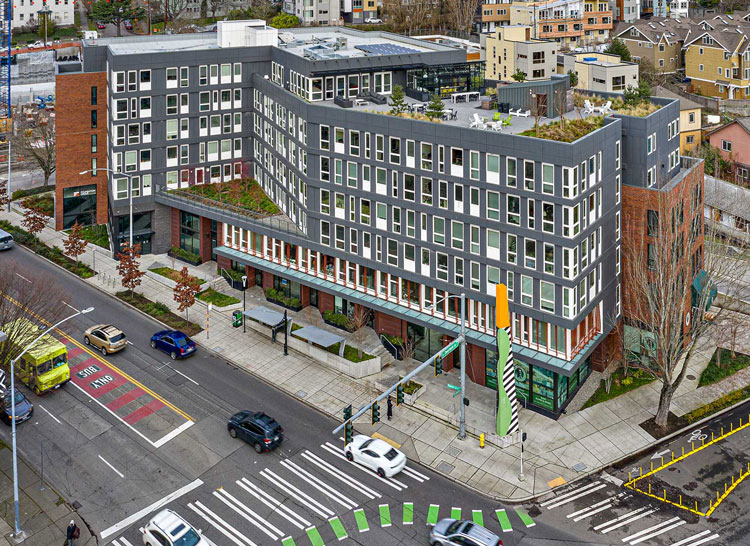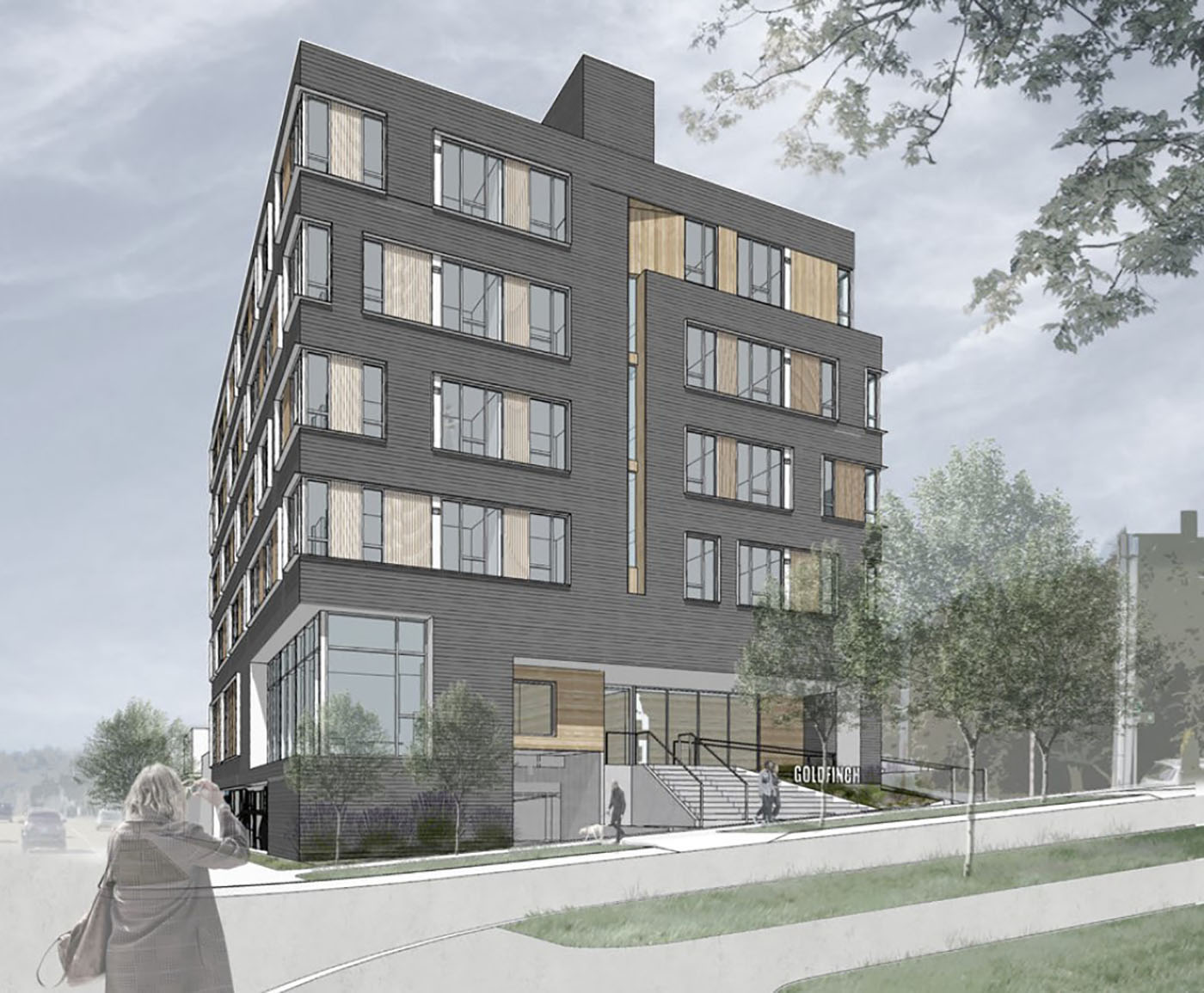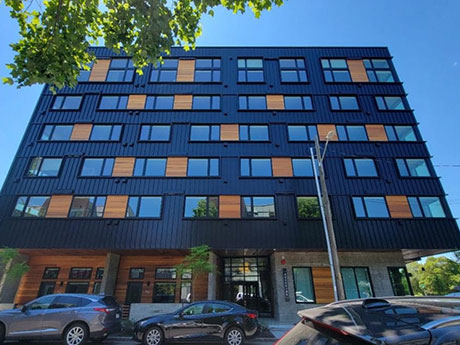It’s been quite the run for Seattle. Like many secondary markets out West, the Emerald City was a pandemic darling, racking up loads of new residents and workers over the past few years. Seattle-area employers added more than 102,600 workers in 2021 alone, according to Marcus & Millichap’s second-quarter market report, which predicts the area will add another 85,000 workers by year’s end.
The report also forecasts Seattle’s population will increase by more than 220,000 residents over the next five years. All this activity has led to a bull run for multifamily owners, investors and developers. Net absorption in Seattle’s central business district surpassed the 5,000-unit mark for the first time on record last year, while rents have risen by 14 percent year over year.
Demand was so fierce that all 20 of the metro’s submarkets recorded vacancy compression over the past four quarters, resulting in an average 2.8 percent vacancy rate, according to Marcus & Millichap. This is the lowest rate in two decades. Nearly 9,000 units — representing 1.9 percent of the supply — were added over the 12-month period that ended in March, with another 25,000 units still under construction at the end of the second quarter.
But things have started to change.
Economic Concerns Mount
Demand from renters is still strong, particularly as homeownership has grown more expensive. However, developers and investors are also feeling the pinch resulting from rising interest rates, supply chain difficulties, increasing construction costs and labor shortages.
The U.S. 10-year Treasury yield, the benchmark for permanent, fixed-rate financing, has risen from 1.63 percent at the start of the year to 3.48 percent as of Dec. 14. The 30-day average Secured Overnight Financing Rate (SOFR), the benchmark for short-term variable rate financing, has risen from 0.05 percent to 3.8 percent during the same period. The Federal Reserve on Dec. 14 raised the federal funds rates half a point to a targeted range of 4.25 to 4.5 percent, the highest level in 15 years.
“Buyers are uncertain of the future and are perceiving more risk, and their real costs have increased,” says Dan Swanson, executive vice president and shareholder at Kidder Mathews, a West Coast-based commercial real estate firm.
Derrick Belgarde, executive director of Chief Seattle Club, a housing and human services agency serving Native Americans, notes these current issues are having a trickle-down effect that ultimately impacts all types of housing availability in both the short and long term.
“Inflation is causing construction costs to increase, which affects supply,” he explains. “Rising interest rates are making folks hold onto single-family homes a little longer now, so older single-family homes that could be redeveloped into multifamily units aren’t as available. Then, supply chain and labor shortages — even on what seems like small items or projects — are extending the construction period for projects by months at a time.”
Headwinds Create Buying Opportunities
Interestingly, in some ways these conditions have benefited advocacy programs like Belgarde’s Native American-led housing and human services agency, as well as the Low-Income Housing Institute (LIHI), a local nonprofit housing organization. That’s because some developers are looking to unload, and fast.
“As developers are winding down construction, they are now faced with much higher interest rates for long-term debt and greater equity requirements,” says Sharon Lee, executive director of LIHI. “If they are able to sell to nonprofits, they can more quickly repay investors and redeploy their capital.”
Lee notes that the softening real estate market allowed LIHI to recently purchase seven properties in the Seattle region. This included five newly completed market-rate buildings and two existing hotels that will now house homeless individuals and low-wage workers. LIHI has purchase agreements to buy four more properties in Seattle, Tacoma and Olympia.
“The housing we are buying from for-profit developers is brand new. [The developments] are small-efficiency studio units with kitchens, many with in-unit washers and dryers, some with sleeping lofts and high-end finishes,” Lee continues. “These were originally intended to rent for $1,800 to $2,200 per month for young professionals and tech workers.”
Lee says this is a winning strategy, even as costs rise.
“In order to move forward to close 4 percent and 9 percent housing tax credit deals, many of us have to reset our budgets to respond to unusually high construction costs,” she explains.
The Low-Income Housing Tax Credit program is designed to subsidize either 30 percent or 70 percent of the low-income unit costs in a project, according to Novogradac, a consulting firm specializing in real estate taxation and accounting. The 30 percent subsidy, which is known as the so-called automatic 4 percent tax credit, covers new construction that uses additional subsidies or the acquisition cost of existing buildings. The 70 percent subsidy, or 9 percent tax credit, supports new construction without any additional federal subsidies. Either tax credit can be claimed for up to 10 years.
“Because of rising interest rates and the cost of capital and land, it is advantageous for nonprofits to acquire newly constructed buildings,” says Lee. “Brand-new buildings are coming in at a per-unit price that we can’t beat if constructing them from scratch today. Given the housing and homelessness crisis, we would also have to wait three to four years for affordable housing to get constructed.”
Individuals who need assistance can’t wait that long. The latest (2020) figures for Seattle/King County show nearly 12,000 people experienced homelessness, with 47 percent being unsheltered. This is a 5 percent increase compared with 2019.
That’s why solutions like the city’s Rapid Housing Acquisition Program loan were created. This program, in addition to other forms of assistance, allowed LIHI to close on the 93-unit Dockside Apartments in the Green Lake submarket (north of Downtown Seattle) in June for $32.7 million. The property was acquired in just 60 days.
The newly built units include a mix of studios and studios with lofts. LIHI will designate 70 units as supportive housing for homeless singles and couples, while 22 units will provide housing for low-wage workers earning 50 percent to 60 percent of the area median income (the manager will occupy the remaining unit).
A similar story played out for the Chief Seattle Club, which was able to purchase the newly built 66-unit Goldfinch apartment building at 4711 Aurora Avenue N in the Fremont submarket for $20.4 million in May. The seller was Kamiak, a local investment firm. Like Lee, Belgarde notes that opportunities exist to purchase new housing inventory as investors take stock of current market conditions.
“With stiff market competition, new developments that might now be nearing completion can increase the available affordable housing stock should those developers decide to sell to the city or county,” he says. “That can turn into affordable or supported housing stock in a matter of months.”
Goldfinch, for one, will re-emerge as permanent supportive housing for seniors.

EverWest Real Estate Investors bought Muir Apartments in Seattle’s central business district for $54.5 million back in May. The Denver-based investment firm is attracted to renter demand fueled by the roster of local employers, such as Microsoft. Rents at the 150-unit Muir start at about $1,705 for a studio, according to the property website.
Long-Term Holders Are Sitting Pretty
Some Seattle-area multifamily buyers and developers are pausing as the economic future remains uncertain. Some sellers with newly completed projects are getting out while they can — so to speak — as they analyze the large supply of units that have recently come on line or that are still due to be delivered through 2022 and beyond.
Some owners are unsure which is the right path for them: sell or hold?
“Higher rates mean buyers aren’t able to pay as much, but many sellers aren’t ready to sell for less,” explains Tom Stover, managing director of acquisitions at Denver-headquartered EverWest Real Estate Investors. “This has created some spread in expectations.”
If current Seattle multifamily owners do sell, what would they buy?
“To sell a property and hold or invest capital comes with risk as well that many owners don’t care to take on by selling their properties,” adds Swanson. “Owners, in many cases, are having their best months of cash flow since 2019.”
Dave Karson, vice chairman of Cushman & Wakefield, cites a few reasons for this healthy cash flow.
“Job growth, a very strong labor pool and high quality of life [all entice workers to Seattle],” he says. “The pace of new supply has also been dampened as the current economic factors generally run counter to accelerated growth, which should be supportive of existing inventory.”
Stover is one investor who won’t be pulling up his stakes in Seattle anytime soon.
“We are bullish on the metro Seattle multifamily market,” he says. “There are a lot of long-term owners here. EverWest is a long-term investor. We select assets based on their sustained growth potential, and Seattle is a market that rises to that standard.”
Stover is particularly keen on strategic buy opportunities in Seattle’s core and on metro Bellevue’s east side. He cites “exceptional fundamentals,” including land constraints, strong property values, and high demand due to the notable price difference between the rent and buy markets.
Realtor.com’s September rental report notes that the median rent in the Seattle-Tacoma-Bellevue metro was nearly $2,187. The average mortgage payment in the area is $5,133, according to an October report published by Redfin.
“Rents are exceptionally low when compared to single-family housing prices in the area,” Karson adds. “Higher mortgage rates should also keep people in the rental pool longer.”
New projects may also sway some investors to continue holding. Karson notes there is more than 5 million square feet of pre-leased office tower space under development in metro Seattle, which could produce more than 25,000 new high-paying jobs over the next few years.
There were 20 major office projects under construction in the third quarter, according to Kidder Mathews’ recent Seattle office report. This includes Microsoft’s 2.5-million-square-foot campus expansion in Redmond; three Amazon towers in Bellevue; and a 347,000-square-foot office building in the Lower Queen Anne/Lake Union submarket that touts Google as the major tenant. This is in addition to about 900,000 square feet of life sciences projects under construction.
It’s names like these that continue to attract investors like EverWest. Stover notes that part of his attraction to Seattle’s core and Bellevue’s east side is the employer roster.
“These areas also have very strong job markets and, therefore, high renter demand fueled by powerhouse companies like Microsoft, Google, Meta and Amazon,” he adds. “Our site selection focuses on high-quality assets in established urban neighborhoods at properties that allow us to improve revenue through management efficiencies and long-term rent growth.”
In May, this type of strategy led EverWest to purchase Muir Apartments, a 130-unit Class A mid-rise in Seattle’s central business district for $54.5 million.
“This is a high-barrier-to-entry micro-location in Seattle’s CBD that has great connectivity to both downtown and the east side through public transportation and nearby interstates,” says Stover.

Chief Seattle Club, a Seattle-based nonprofit, purchased the newly built Goldfinch apartment building in the Fremont submarket for $20.4 million in May. The seller was local investment firm Kamiak, which developed the 66-unit property. Chief Seattle Club is planning to offer permanent supportive housing for seniors at the property.
Amenities Target Young Professionals
Many investors that are staying or expanding are following the region’s employment sector closely. This isn’t just to ensure there is a built-in renter cohort — spoiler alert: there is — but to keep tabs on what these employees want.
“The employees who work for many of these tech companies are often young and rising professionals,” explains Stover. “We keep this in mind when we buy, tending toward the newer, more amenitized product that this type of renter prefers. We often make some degree of capital improvements after purchasing an asset, such as installing new appliance packages, addressing deferred maintenance and incorporating accretive capital investment, in addition to achieving optimal revenue by deploying institutional management efficiencies that were not in place before.”
EverWest hasn’t announced any plans for Muir Apartments yet, though the asset only debuted in 2019. The high-end amenity package includes a rooftop deck with views of the Seattle skyline and Mount Rainier, as well as a location that offers a mix of restaurants, retail and cultural attractions.
Karson has seen the demand for upscale amenity packages as well.
“New developments have generally become larger with more significant amenity bases, while proximity to the growing urban tech campuses also has significant appeal,” he says.
Such was the case with The Confidential, a 29-story, 212-unit mixed-use building being developed in the Belltown submarket. The 374,000-square-foot building is expected to include a fitness center, lounge and theater when it opens in 2024.
Cushman & Wakefield procured a $193 million development funding package on behalf of Seattle-based Security Properties for the project in June. The package includes a $65.2 million joint venture equity investment with MetLife Investment Management and $115.3 million in construction financing from Bank OZK.
With 17,500 square feet of office space and apartments that offer work-from-home nooks in a neighborhood on the edge of downtown Seattle, investors have much to be excited about as select projects like The Confidential come to fruition.
— Nellie Day


